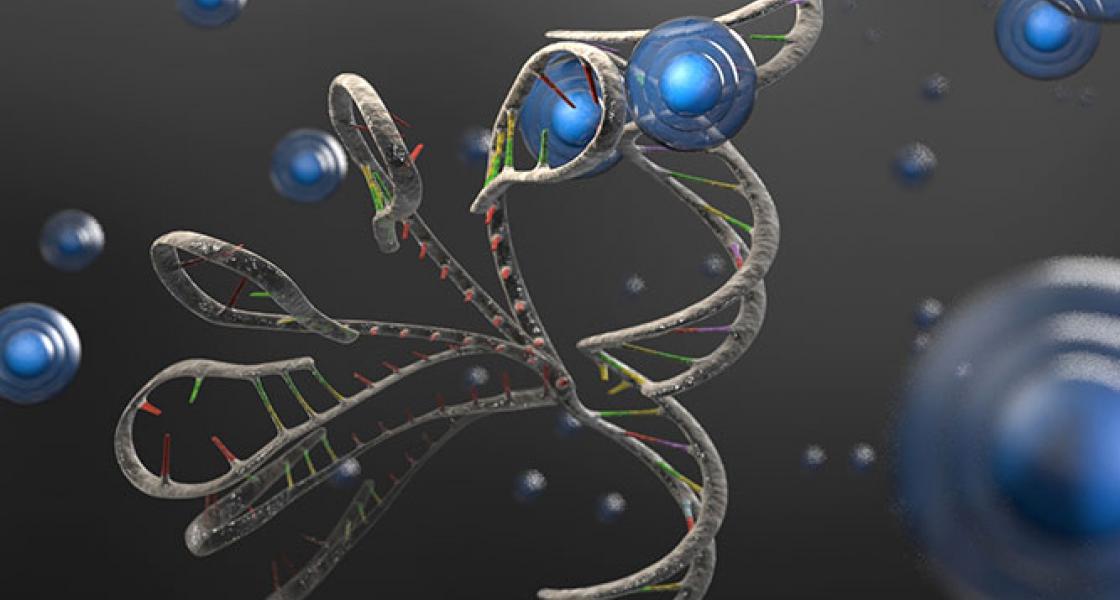Biomolecules may not always behave the same way in test tubes as they do in living cells, a fact underscored by important new work by former research associate Nick Dupuis, graduate student Erik Holmstrom, and Fellow David Nesbitt. The researchers found that under crowded conditions that begin to mimic those found in cells, single RNA molecules folded 35 times faster than in the dilute solutions typically used in test-tube experiments. Crowding also led to a modest decrease in the unfolding rate. The results strongly support the idea that compact structures, such as folded RNA molecules and proteins, may be much more stable in living cells than they are in test tubes, where there’s lots of room to stretch out and flop around.
The idea that crowding favors compact structures in cells makes intuitive sense. Imagine trying to make headway through a crowd at a popular concert or sports event. Keeping your arms and possessions close to your body works much better for making headway through a throng of people than waving your arms and packages as far away from your body as possible. The same principles apply to biological activity inside cells. Not surprisingly, the biologicaly active forms of RNA, proteins, and other important large molecules found in cells are nearly always compact, folded structures.
Dupuis and his colleagues’ work on RNA folding under crowded conditions was reported online May 21, 2014 in the Proceedings of the National Academy of Sciences.
The Nesbitt group’s research was the first to use using single-molecule fluorescence techniques to precisely measure the effects of crowding on the rates of folding and unfolding of individual RNA molecules. With this technique, an RNA molecule fluoresces green when it’s unfolded and red when it’s folded. Under crowded conditions, the molecule spent a lot less time green because it folded so much more quickly.
The researchers chose long chains of antifreeze molecules (polyethylene glycol, or PEG) as crowding agents because these molecules just take up lots of space. PEG doesn’t interact with the RNA in any other way. The crowding is enough to put pressure on the RNA to get smaller. And, it turns out that getting smaller (i.e., more compact) makes it more likely the molecules will go on to fold. Interestingly, once the RNA molecules are folded, they unfold just a little bit more slowly than when they’re not crowded. Of course, they don’t stay unfolded for long.
Next, the group plans to take bacterial cells and break them open so it can watch RNA folding in a soup of bacterial innards. This soup will be much more like the crowded environment inside cells. It’s possible the researchers will learn enough about RNA folding in a bacterial soup to go on to investigate single-molecule RNA folding inside a living cell.—Julie Phillips



 The Physics Frontiers Centers (PFC) program supports university-based centers and institutes where the collective efforts of a larger group of individuals can enable transformational advances in the most promising research areas. The program is designed to foster major breakthroughs at the intellectual frontiers of physics by providing needed resources such as combinations of talents, skills, disciplines, and/or specialized infrastructure, not usually available to individual investigators or small groups, in an environment in which the collective efforts of the larger group can be shown to be seminal to promoting significant progress in the science and the education of students. PFCs also include creative, substantive activities aimed at enhancing education, broadening participation of traditionally underrepresented groups, and outreach to the scientific community and general public.
The Physics Frontiers Centers (PFC) program supports university-based centers and institutes where the collective efforts of a larger group of individuals can enable transformational advances in the most promising research areas. The program is designed to foster major breakthroughs at the intellectual frontiers of physics by providing needed resources such as combinations of talents, skills, disciplines, and/or specialized infrastructure, not usually available to individual investigators or small groups, in an environment in which the collective efforts of the larger group can be shown to be seminal to promoting significant progress in the science and the education of students. PFCs also include creative, substantive activities aimed at enhancing education, broadening participation of traditionally underrepresented groups, and outreach to the scientific community and general public.